Synthesis, Characterization and Photodynamic Activity against Bladder Cancer Cells of Novel Triazole-Porphyrin Derivatives
Abstract
:1. Introduction
2. Results and Discussion
2.1. Synthesis and Characterization of New β-Substituted Triazole-porphyrin Derivatives (TZ-PORs)
2.2. Incorporation of β-Substituted Triazole-Porphyrins 7a–f into PVP Micelles
2.3. Photophysical Characterization of TZ-POR 7a–f and Formulations PVP-TZ-POR 7a–f
2.4. Singlet Oxygen and Photostability Studies of the PVP-TZ-POR 7a–f Formulations
2.5. In Vitro Studies of the Photodynamic Effect of PVP-TZ-POR 7a–f in Human Bladder Cancer Cells
2.5.1. Cellular Uptake of PVP-TZ-POR 7a–f
2.5.2. Cell Viability after PDT Treatment with PVP-TZ-POR 7a–f
3. Materials and Methods
3.1. Synthesis and Characterization of New β-Substituted Triazole-porphyrin Derivatives (TZ-PORs)
3.1.1. General Procedure for 4-Vinyl-1,2,3-triazoles 1a–f
3.1.2. Synthesis of 2-Bromo-5,10,15,20-tetraphenylporphyrinatozinc(II) (2)
3.1.3. General Procedure for the Heck Coupling Reactions of 2-Bromo-5,10,15,20-tetraphenylporphyrinatozinc(II) (2) and 4-Vinyl-1,2,3-triazoles 1a–f
3.1.4. General Procedure for the Decomplexation of TZ-POR 6a–f Derivatives
3.1.5. General Procedure for the Incorporation of TZ-POR 7a–f Derivatives into PVP Micelles
3.1.6. Singlet Oxygen Generation Studies
3.1.7. Photostability Assays
3.2. In Vitro Studies of the Photodynamic Effect of PVP-TZ-POR 7a–f in Human Bladder Cancer Cells
3.2.1. Cellular Uptake of PVP-TZ-POR 7a–f
3.2.2. Phototoxicity of PVP-TZ-POR 7a–f Formulations
3.2.3. MTT Assay
3.2.4. Statistical Analysis
4. Conclusions
Abbreviations
| Ce6 | Chlorin e6 |
| DPiBF | 1,3-diphenylisobenzofuran |
| IBX | 2-iodoxybenzoic acid |
| PDT | Photodynamic Therapy |
| PS | Photosensitizer |
| PVP | polyvinylpyrrolidone |
| PVP-TPP | polyvinylpyrrolidone-tetraphenylporphyrin micelles |
| PVP-TZ-POR | polyvinylpyrrolidone-triazole-porphyrin formulation |
| TFA | trifluoroacetic acid |
| TLC | thin layer chromatography |
| TZ-POR | triazole-porphyrin derivative. |
Supplementary Materials
Author Contributions
Funding
Conflicts of Interest
References
- Paolesse, R.; Nardis, S.; Monti, D.; Stefanelli, M.; Di Natale, C. Porphyrinoids for chemical sensor applications. Chem. Rev. 2017, 117, 2517–2583. [Google Scholar] [CrossRef] [PubMed] [Green Version]
- Costa, L.D.; Costa, J.I.T.; Tome, A.C. Porphyrin macrocycle modification: Pyrrole ring-contracted or -expanded porphyrinoids. Molecules 2016, 21, 320. [Google Scholar] [CrossRef] [PubMed] [Green Version]
- D’Souza, F.; Ito, O. Tetrapyrrole–nanocarbon hybrids: Self-assembly and photoinduced electron transfer. In Handbook of Porphyrin Science; World Scientific Publishing Company: Singapore, 2012; pp. 307–437. [Google Scholar]
- Li, B.; Lin, L.; Lin, H.; Wilson, B.C. Photosensitized singlet oxygen generation and detection: Recent advances and future perspectives in cancer photodynamic therapy. J. Biophotonics 2016, 9, 1314–1325. [Google Scholar] [CrossRef] [PubMed] [Green Version]
- Skupin-Mrugalska, P.; Piskorz, J.; Goslinski, T.; Mielcarek, J.; Konopka, K.; Düzgüneş, N. Current status of liposomal porphyrinoid photosensitizers. Drug Discov. Today 2013, 18, 776–784. [Google Scholar] [CrossRef]
- Li, L.; Huh, K.M. Polymeric nanocarrier systems for photodynamic therapy. Biomater. Res. 2014, 18, 19–33. [Google Scholar] [CrossRef] [Green Version]
- Patel, N.; Pera, P.; Joshi, P.; Dukh, M.; Tabaczynski, W.A.; Siters, K.E.; Kryman, M.; Cheruku, R.R.; Durrani, F.; Missert, J.R.; et al. Highly effective dual-function near-infrared (NIR) photosensitizer for fluorescence imaging and photodynamic therapy (PDT) of cancer. J. Med. Chem. 2016, 59, 9774–9787. [Google Scholar] [CrossRef]
- Kessel, D. 21 mechanisms of cell death in photodynamic therapy. In Handbook of Porphyrin Science; World Scientific Publishing Company: Singapore, 2012; pp. 403–423. [Google Scholar]
- Jux, N.; Röder, B. 20 Targeting strategies for tetrapyrrole-based photodynamic therapy. In Handbook of Porphyrin Science; World Scientific Publishing Company: Singapore, 2012; pp. 325–401. [Google Scholar]
- Gomer, C.J.; Ferrario, A.; Luna, M.; Rucker, N.; Wong, S.; Bozkulak, O.; Xu, F. 22 Photodynamic therapy and the tumor microenvironment. In Handbook of Porphyrin Science; World Scientific Publishing Company: Singapore, 2012; pp. 425–441. [Google Scholar]
- Alonso, C.; Boyle, R.W. 17 Bioconjugates of porphyrins and related molecules for photodynamic therapy. In Handbook of Porphyrin Science; World Scientific Publishing Company: Singapore, 2012; pp. 121–190. [Google Scholar]
- Ghazal, B.; Machacek, M.; Shalaby, M.A.; Novakova, V.; Zimcik, P.; Makhseed, S. Phthalocyanines and tetrapyrazinoporphyrazines with two cationic donuts: High photodynamic activity as a result of rigid spatial arrangement of peripheral substituents. J. Med. Chem. 2017, 60, 6060–6076. [Google Scholar] [CrossRef]
- Gomes, A.T.P.C.; Neves, M.G.P.M.S.; Cavaleiro, J.A.S. Cancer, photodynamic therapy and porphyrin-type derivatives. Anais da Academia Brasileira de Ciências 2018, 90, 993–1026. [Google Scholar] [CrossRef]
- Ferreira, J.; Menezes, P.F.C.; Kurachi, C.; Sibata, C.; Allison, R.R.; Bagnato, V.S. Photostability of different chlorine photosensitizers. Laser Phys. Lett. 2008, 5, 156–161. [Google Scholar] [CrossRef]
- Zheng, X.; Pandey, R.K. Porphyrin-carbohydrate conjugates: Impact of carbohydrate moieties in photodynamic therapy (PDT). Anticancer Agents Med. Chem. 2008, 8, 241–268. [Google Scholar] [CrossRef]
- Jeong, H.G.; Choi, M.S. Design and properties of porphyrin-based singlet oxygen generator. Isr. J. Chem. 2016, 56, 110–118. [Google Scholar] [CrossRef]
- Lange, C.; Bednarski, P.J. Photosensitizers for photodynamic therapy: Photochemistry in the service of oncology. Curr. Pharm. Des. 2016, 22, 6956–6974. [Google Scholar] [CrossRef] [PubMed]
- Abrahamse, H.; Hamblin, M.R. New photosensitizers for photodynamic therapy. Biochem. J. 2016, 473, 347–364. [Google Scholar] [CrossRef] [PubMed] [Green Version]
- Gomes, A.T.P.C.; Faustino, M.A.F.; Neves, M.G.P.M.S.; Ferreira, V.F.; Juarranz, A.; Cavaleiro, J.A.S.; Sanz-Rodriguez, F. Photodynamic effect of glycochlorin conjugates in human cancer epithelial cells. RSC Adv. 2015, 5, 33496–33502. [Google Scholar] [CrossRef]
- Luo, D.D.; Carter, K.A.; Miranda, D.; Lovell, J.F. Chemophototherapy: An emerging treatment option for solid tumors. Adv. Sci. 2017, 4, 1600106. [Google Scholar] [CrossRef] [Green Version]
- Tsolekile, N.; Nelana, S.; Oluwafemi, O.S. Porphyrin as diagnostic and therapeutic agent. Molecules 2019, 24, 2669. [Google Scholar] [CrossRef] [Green Version]
- Bonnett, R. Chemical Aspects of Photodynamic Therapy; Gordon and Breach Science Publishers: Amsterdam, The Netherlands, 2000. [Google Scholar]
- Dias, C.J.; Sardo, I.; Moura, N.M.M.; Felgueiras, J.; Neves, M.G.P.M.S.; Fardilha, M.; Faustino, M.A.F. An efficient synthetic access to new uracil-alditols bearing a porphyrin unit and biological assessment in prostate cancer cells. Dye. Pigment. 2020, 173, 107996. [Google Scholar] [CrossRef]
- Lafont, D.; Zorlu, Y.; Savoie, H.; Albrieux, F.; Ahsen, V.; Boyle, R.W.; Dumoulin, F. Monoglycoconjugated phthalocyanines: Effect of sugar and linkage on photodynamic activity. Photodiagnosis Photodyn. Ther. 2013, 10, 252–259. [Google Scholar] [CrossRef]
- Pereira, P.M.R.; Silva, S.; Ramalho, J.S.; Gomes, C.M.; Girão, H.; Cavaleiro, J.A.S.; Ribeiro, C.A.F.; Tomé, J.P.C.; Fernandes, R. The role of galectin-1 in in vitro and in vivo photodynamic therapy with a galactodendritic porphyrin. Eur. J. Cancer 2016, 68, 60–69. [Google Scholar] [CrossRef]
- Pereira, P.M.R.; Silva, S.; Bispo, M.; Zuzarte, M.; Gomes, C.; Girão, H.; Cavaleiro, J.A.S.; Ribeiro, C.A.F.; Tomé, J.P.C.; Fernandes, R. Mitochondria-targeted photodynamic therapy with a galactodendritic chlorin to enhance cell death in resistant bladder cancer cells. Bioconjug. Chem. 2016, 27, 2762–2769. [Google Scholar] [CrossRef]
- Mazzaglia, A.; Angelini, N.; Darcy, R.; Donohue, R.; Lombardo, D.; Micali, N.; Sciortino, M.T.; Villari, V.; Scolaro, L.M. Novel heterotopic colloids of anionic porphyrins entangled in cationic amphiphilic cyclodextrins: Spectroscopic investigation and intracellular delivery. Chem. Eur. J. 2003, 9, 5762–5769. [Google Scholar] [CrossRef] [PubMed]
- Sortino, S.; Mazzaglia, A.; Monsù Scolaro, L.; Marino Merlo, F.; Valveri, V.; Sciortino, M.T. Nanoparticles of cationic amphiphilic cyclodextrins entangling anionic porphyrins as carrier-sensitizer system in photodynamic cancer therapy. Biomaterials 2006, 27, 4256–4265. [Google Scholar] [CrossRef] [PubMed]
- Lourenço, L.M.O.; Pereira, P.M.R.; Maciel, E.; Valega, M.; Domingues, F.M.J.; Domingues, M.R.M.; Neves, M.G.P.M.S.; Cavaleiro, J.A.S.; Fernandes, R.; Tome, J.P.C. Amphiphilic phthalocyanine-cyclodextrin conjugates for cancer photodynamic therapy. Chem. Commun. 2014, 50, 8363–8366. [Google Scholar] [CrossRef] [PubMed]
- Barata, J.F.B.; Zamarrón, A.; Neves, M.G.P.M.S.; Faustino, M.A.F.; Tomé, A.C.; Cavaleiro, J.A.S.; Röder, B.; Juarranz, Á.; Sanz-Rodríguez, F. Photodynamic effects induced by meso-tris(pentafluorophenyl)corrole and its cyclodextrin conjugates on cytoskeletal components of HeLa cells. Eur. J. Med. Chem. 2015, 92, 135–144. [Google Scholar] [CrossRef] [PubMed]
- Hudson, R.; Carcenac, M.; Smith, K.; Madden, L.; Clarke, O.J.; Pelegrin, A.; Greenman, J.; Boyle, R.W. The development and characterisation of porphyrin isothiocyanate-monoclonal antibody conjugates for photoimmunotherapy. Br. J. Cancer 2005, 92, 1442–1449. [Google Scholar] [CrossRef] [PubMed] [Green Version]
- Pereira, P.M.R.; Carvalho, J.J.; Silva, S.; Cavaleiro, J.A.S.; Schneider, R.J.; Fernandes, R.; Tome, J.P.C. Porphyrin conjugated with serum albumins and monoclonal antibodies boosts efficiency in targeted destruction of human bladder cancer cells. Org. Biomol. Chem. 2014, 12, 1804–1811. [Google Scholar] [CrossRef]
- Pereira, P.M.R.; Korsak, B.; Sarmento, B.; Schneider, R.J.; Fernandes, R.; Tome, J.P.C. Antibodies armed with photosensitizers: From chemical synthesis to photobiological applications. Org. Biomol. Chem. 2015, 13, 2518–2529. [Google Scholar] [CrossRef]
- Dheer, D.; Singh, V.; Shankar, R. Medicinal attributes of 1,2,3-triazoles: Current developments. Bioorg. Chem. 2017, 71, 30–54. [Google Scholar] [CrossRef]
- Duan, Y.-C.; Ma, Y.-C.; Zhang, E.; Shi, X.-J.; Wang, M.-M.; Ye, X.-W.; Liu, H.-M. Design and synthesis of novel 1,2,3-triazole-dithiocarbamate hybrids as potential anticancer agents. Eur. J. Med. Chem. 2013, 62, 11–19. [Google Scholar] [CrossRef]
- Bock, V.D.; Speijer, D.; Hiemstra, H.; van Maarseveen, J.H. 1,2,3-Triazoles as peptide bond isosteres: Synthesis and biological evaluation of cyclotetrapeptide mimics. Org. Biomol. Chem. 2007, 5, 971–975. [Google Scholar] [CrossRef]
- Pingaew, R.; Prachayasittikul, V.; Mandi, P.; Nantasenamat, C.; Prachayasittikul, S.; Ruchirawat, S.; Prachayasittikul, V. Synthesis and molecular docking of 1,2,3-triazole-based sulfonamides as aromatase inhibitors. Org. Biomol. Chem. 2015, 23, 3472–3480. [Google Scholar] [CrossRef] [PubMed]
- Szabó, J.; Jerkovics, N.; Schneider, G.; Wölfling, J.; Bózsity, N.; Minorics, R.; Zupkó, I.; Mernyák, E. Synthesis and in vitro antiproliferative evaluation of C-13 epimers of triazolyl-d-secoestrone alcohols: The first potent 13α-d-secoestrone derivative. Molecules 2016, 21, 611. [Google Scholar] [CrossRef] [PubMed] [Green Version]
- Romagnoli, R.; Baraldi, P.G.; Cruz-Lopez, O.; Lopez Cara, C.; Carrion, M.D.; Brancale, A.; Hamel, E.; Chen, L.; Bortolozzi, R.; Basso, G.; et al. Synthesis and antitumor activity of 1,5-disubstituted 1,2,4-triazoles as cis-restricted combretastatin analogues. J. Med. Chem. 2010, 53, 4248–4258. [Google Scholar] [CrossRef] [PubMed] [Green Version]
- Vo, D.D.; Gautier, F.; Barille-Nion, S.; Juin, P.; Levoin, N.; Gree, R. Design, synthesis and biological evaluation of new inhibitors of Bax/Bcl-xL interaction in cancer cells. Bioorg. Med. Chem. Lett. 2014, 24, 1758–1761. [Google Scholar] [CrossRef]
- Ladomenou, K.; Nikolaou, V.; Charalambidis, G.; Coutsolelos, A.G. “Click”-reaction: An alternative tool for new architectures of porphyrin based derivatives. Coord. Chem. Rev. 2016, 306, 1–42. [Google Scholar] [CrossRef]
- Dumoulin, F.; Ahsen, V. Click chemistry: The emerging role of the azide-alkyne Huisgen dipolar addition in the preparation of substituted tetrapyrrolic derivatives. J. Porphyr. Phthalocyanines 2011, 15, 481–504. [Google Scholar] [CrossRef]
- Wirotius, A.-L.; Ibarboure, E.; Scarpantonio, L.; Schappacher, M.; McClenaghan, N.D.; Deffieux, A. Hydrosoluble dendritic poly(ethylene oxide)s with zinc tetraphenylporphyrin branching points as photosensitizers. Polym. Chem. 2013, 4, 1903–1912. [Google Scholar] [CrossRef]
- Hijazi, I.; Jousselme, B.; Jegou, P.; Filoramo, A.; Campidelli, S. Formation of linear and hyperbranched porphyrin polymers on carbon nanotubes via a CuAAC “grafting from” approach. J. Mater. Chem. 2012, 22, 20936–20942. [Google Scholar] [CrossRef]
- Thandu, M.; Rapozzi, V.; Xodo, L.; Albericio, F.; Comuzzi, C.; Cavalli, S. “Clicking” porphyrins to magnetic nanoparticles for photodynamic therapy. ChemPlusChem 2014, 79, 90–98. [Google Scholar] [CrossRef]
- Daly, R.; Vaz, G.; Davies, A.M.; Senge, M.O.; Scanlan, E.M. Synthesis and biological evaluation of a library of glycoporphyrin compounds. Chem. Eur. J. 2012, 18, 14671–14679. [Google Scholar] [CrossRef] [Green Version]
- Garcia, G.; Naud-Martin, D.; Carrez, D.; Croisy, A.; Maillard, P. Microwave-mediated ‘click-chemistry’ synthesis of glycoporphyrin derivatives and in vitro photocytotoxicity for application in photodynamic therapy. Tetrahedron 2011, 67, 4924–4932. [Google Scholar] [CrossRef]
- Hao, E.; Jensen, T.J.; Vicente, M.G.H. Synthesis of porphyrin-carbohydrate conjugates using “click” chemistry and their preliminary evaluation in human HEp2 cells. J. Porphyr. Phthalocyanines 2009, 13, 51–59. [Google Scholar] [CrossRef]
- Da Silva, F.I.; RC Martins, P.; da Silva, E.; Ferreira, B.S.; Ferreira, F.V.; da Costa, R.C.; Vasconcellos, C.d.M.; Lima, S.E.; da Silva, d.C.F. Synthesis of 1H-1,2,3-triazoles and study of their antifungal and cytotoxicity activities. Med. Chem. 2013, 9, 1085–1090. [Google Scholar] [CrossRef] [PubMed]
- Gonsalves, A.D.; Varejão, J.M.; Pereira, M.M. Some new aspects related to the synthesis of meso-substituted porphyrins. J. Heterocycl. Chem. 1991, 28, 635–640. [Google Scholar] [CrossRef]
- Callot, H.J. Bromination of meso-tetraphenylporphine. Preparation of alkyl derivatives and polycyanoporphines. Bull. Soc. Chim. Fr. 1974, 7, 1492–1496. [Google Scholar]
- Campos, V.R.; Gomes, A.T.P.C.; Cunha, A.C.; Neves, M.G.P.M.S.; Ferreira, V.F.; Cavaleiro, J.A.S. Efficient access to beta-vinylporphyrin derivatives via palladium cross coupling of beta-bromoporphyrins with N-tosylhydrazones. Beilstein J. Org.Chem. 2017, 13, 195–202. [Google Scholar] [CrossRef] [Green Version]
- Mesquita, M.Q.; Dias, C.J.; Gamelas, S.; Fardilha, M.; Neves, M.G.P.M.S.; Faustino, M.A.F. An insight on the role of photosensitizer nanocarriers for photodynamic therapy. An. Bras. Acad. Sci. 2018, 90, 1101–1130. [Google Scholar] [CrossRef] [Green Version]
- Hädener, M.; Gjuroski, I.; Furrer, J.; Vermathen, M. Interactions of polyvinylpyrrolidone with chlorin e6-based photosensitizers studied by NMR and electronic absorption spectroscopy. J. Phys. Chem. B 2015, 119, 12117–12128. [Google Scholar] [CrossRef]
- Copley, L.; van der Watt, P.; Wirtz, K.W.; Parker, M.I.; Leaner, V.D. Photolon™, a chlorin e6 derivative, triggers ROS production and light-dependent cell death via necrosis. Int. J. Biochem. Cell Biol. 2008, 40, 227–235. [Google Scholar] [CrossRef]
- Chin, W.W.L.; Heng, P.W.S.; Bhuvaneswari, R.; Lau, W.K.O.; Olivo, M. The potential application of chlorin e6-polyvinylpyrrolidone formulation in photodynamic therapy. Photochem. Photobiol. Sci. 2006, 5, 1031–1037. [Google Scholar] [CrossRef]
- Chin, W.W.L.; Heng, P.W.S.; Thong, P.S.P.; Bhuvaneswari, R.; Hirt, W.; Kuenzel, S.; Soo, K.C.; Olivo, M. Improved formulation of photosensitizer chlorin e6 polyvinylpyrrolidone for fluorescence diagnostic imaging and photodynamic therapy of human cancer. Eur. J. Pharm. Biopharm. 2008, 69, 1083–1093. [Google Scholar] [CrossRef] [PubMed]
- Ali-Seyed, M.; Bhuvaneswari, R.; Soo, K.C.; Olivo, M. Photolon (TM)—Photosensitization induces apoptosis via ROS-mediated cross-talk between mitochondria and lysosomes. Int. J. Oncol. 2011, 39, 821–831. [Google Scholar] [PubMed]
- Chin, W.W.L.; Praveen, T.; Heng, P.W.S.; Olivo, M. Effect of polyvinylpyrrolidone on the interaction of chlorin e6 with plasma proteins and its subcellular localization. Eur. J. Pharm. Biopharm. 2010, 76, 245–252. [Google Scholar] [CrossRef] [PubMed]
- Liang, R.; Ma, L.; Zhang, L.; Li, C.; Liu, W.; Wei, M.; Yan, D.; Evans, D.G.; Duan, X. A monomeric photosensitizer for targeted cancer therapy. Chem. Commun. 2014, 50, 14983–14986. [Google Scholar] [CrossRef] [PubMed]
- Fagadar-Cosma, E.; Tarabukina, E.; Zakharova, N.; Birdeanu, M.; Taranu, B.; Palade, A.; Creanga, I.; Lascu, A.; Fagadar-Cosma, G. Hybrids formed between polyvinylpyrrolidone and an A3B porphyrin dye: Behaviour in aqueous solutions and chemical response to CO2 presence. Polym. Int. 2016, 65, 200–209. [Google Scholar] [CrossRef]
- Moura, N.M.M.; Faustino, M.A.F.; Neves, M.G.P.M.S.; Tomé, A.C.; Rakib, E.M.; Hannioui, A.; Mojahidi, S.; Hackbarth, S.; Röder, B.; Almeida Paz, F.A.; et al. Novel pyrazoline and pyrazole porphyrin derivatives: Synthesis and photophysical properties. Tetrahedron 2012, 68, 8181–8193. [Google Scholar] [CrossRef]
- Saravanakumar, G.; Kim, J.; Kim, W.J. Reactive-oxygen-species-responsive drug delivery systems: Promises and challenges. Adv. Sci. 2017, 4, 1600124–1600143. [Google Scholar] [CrossRef]
- Oda, K.; Ogura, S.-I.; Okura, I. Preparation of a water-soluble fluorinated zinc phthalocyanine and its effect for photodynamic therapy. J. Photochem. Photobiol. B 2000, 59, 20–25. [Google Scholar] [CrossRef]
- Gomes, A.T.P.C.; Cunha, A.C.; Domingues, M.D.M.; Neves, M.G.P.M.S.; Tome, A.C.; Silva, A.M.S.; Santos, F.D.; Souza, M.; Ferreira, V.F.; Cavaleiro, J.A.S. Synthesis and characterization of new porphyrin/4-quinolone conjugates. Tetrahedron 2011, 67, 7336–7342. [Google Scholar] [CrossRef]
- Batalha, P.N.; Gomes, A.; Forezi, L.S.M.; Costa, L.; de Souza, M.; Boechat, F.D.S.; Ferreira, V.F.; Almeida, A.; Faustino, M.A.F.; Neves, M.G.P.M.S.; et al. Synthesis of new porphyrin/4-quinolone conjugates and evaluation of their efficiency in the photoinactivation of Staphylococcus aureus. RSC Adv. 2015, 5, 71228–71239. [Google Scholar] [CrossRef]
- Moura, N.M.M.; Giuntini, F.; Faustino, M.A.F.; Neves, M.G.P.M.S.; Tome, A.C.; Silva, A.M.S.; Rakib, E.M.; Hannioui, A.; Abouricha, S.; Roder, B.; et al. 1,3-Dipolar cycloaddition of nitrile imines to meso-tetraarylporphyrins. Arkivoc 2010, 24, 33. [Google Scholar]
- Kirveliene, V.; Prasmickaite, L.; Kadziauskas, J.; Bonnett, R.; Djelal, B.D.; Juodka, B. Post-exposure processes in Temoporfin-photosensitized cells in vitro: Reliance on energy metabolism. J. Photochem. Photobiol. B 1997, 41, 173–180. [Google Scholar] [CrossRef]
- Priya James, H.; John, R.; Alex, A.; Anoop, K.R. Smart polymers for the controlled delivery of drugs—A concise overview. Acta Pharm. Sin. B 2014, 4, 120–127. [Google Scholar] [CrossRef] [PubMed] [Green Version]
- Kou, L.; Sun, J.; Zhai, Y.; He, Z. The endocytosis and intracellular fate of nanomedicines: Implication for rational design. Asian J. Pharm. Sci. 2013, 8, 1–10. [Google Scholar] [CrossRef] [Green Version]
- Liu, Y.; Wang, W.; Yang, J.; Zhou, C.; Sun, J. pH-sensitive polymeric micelles triggered drug release for extracellular and intracellular drug targeting delivery. Asian J. Pharm. Sci. 2013, 8, 159–167. [Google Scholar] [CrossRef] [Green Version]
- Derycke, A.S.L.; de Witte, P.A.M. Liposomes for photodynamic therapy. Adv. Drug Deliv. Rev. 2004, 56, 17–30. [Google Scholar] [CrossRef]
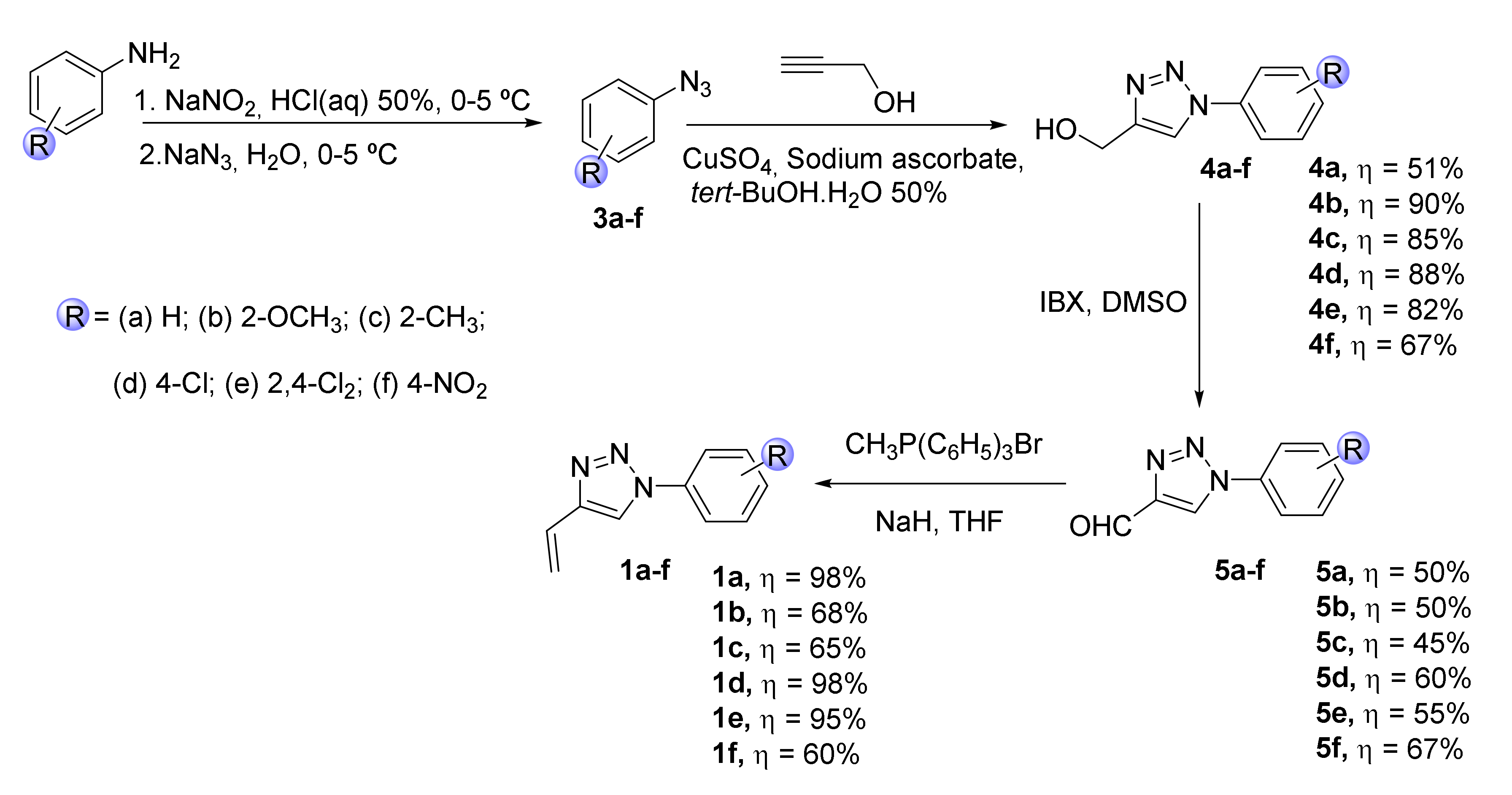
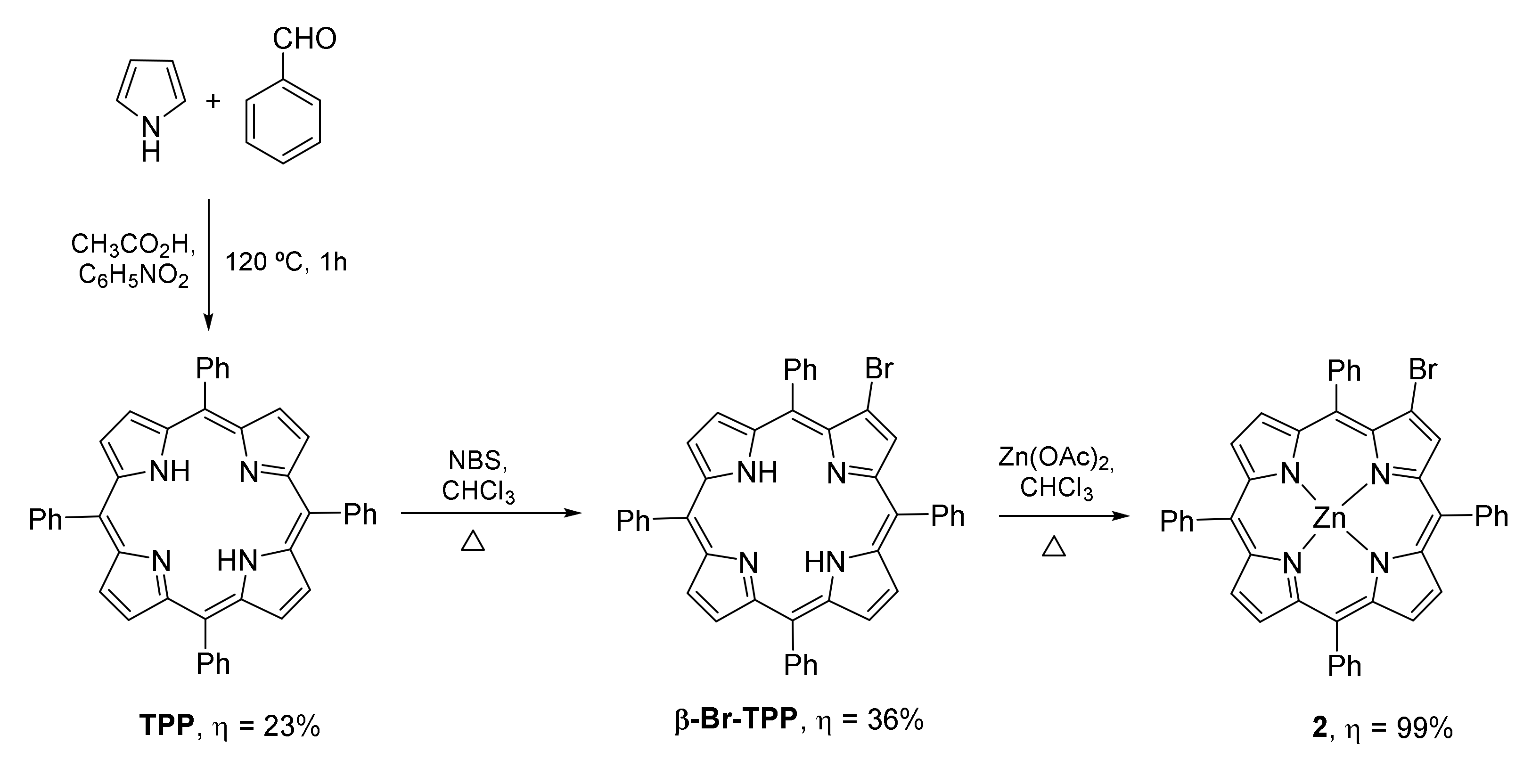
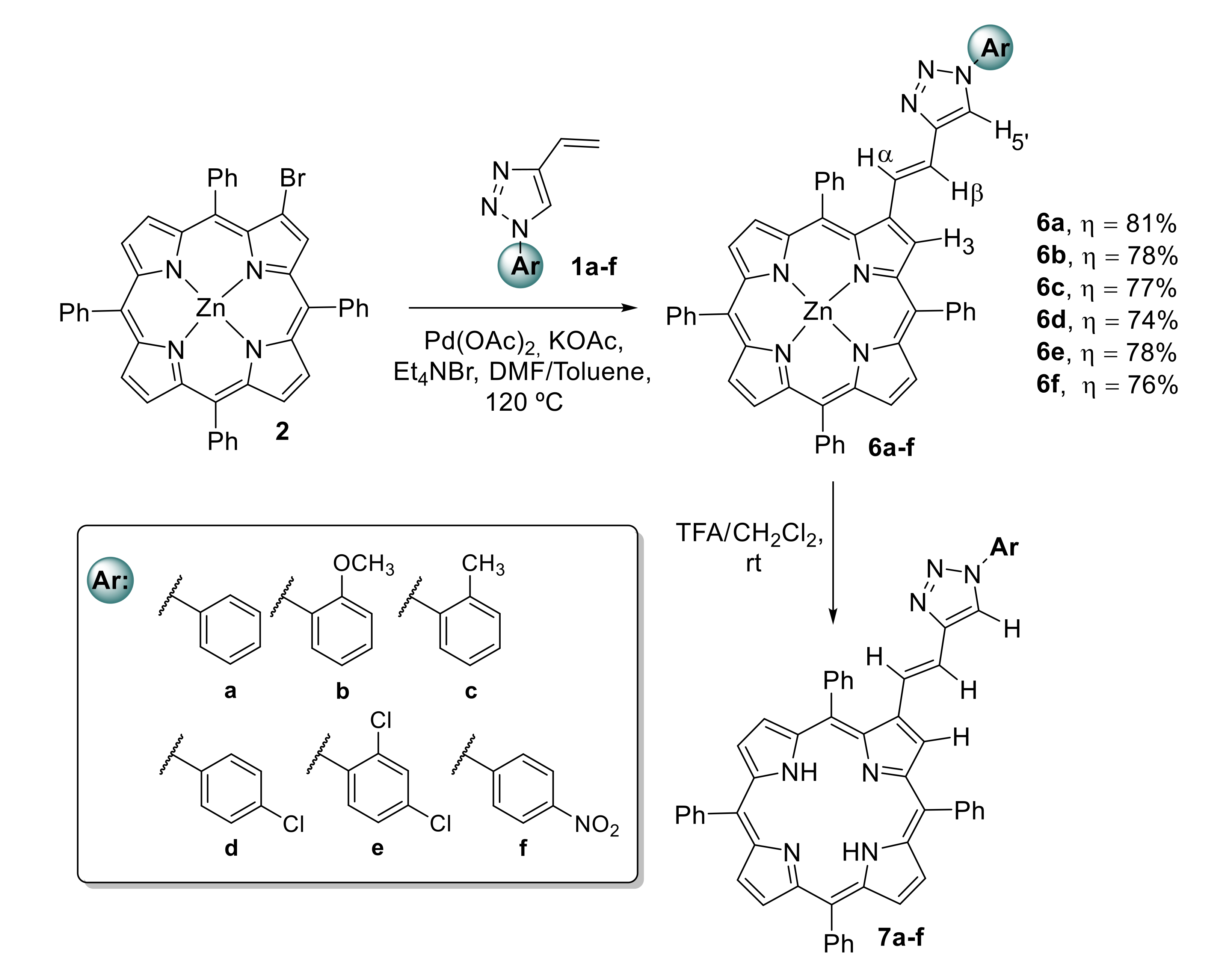


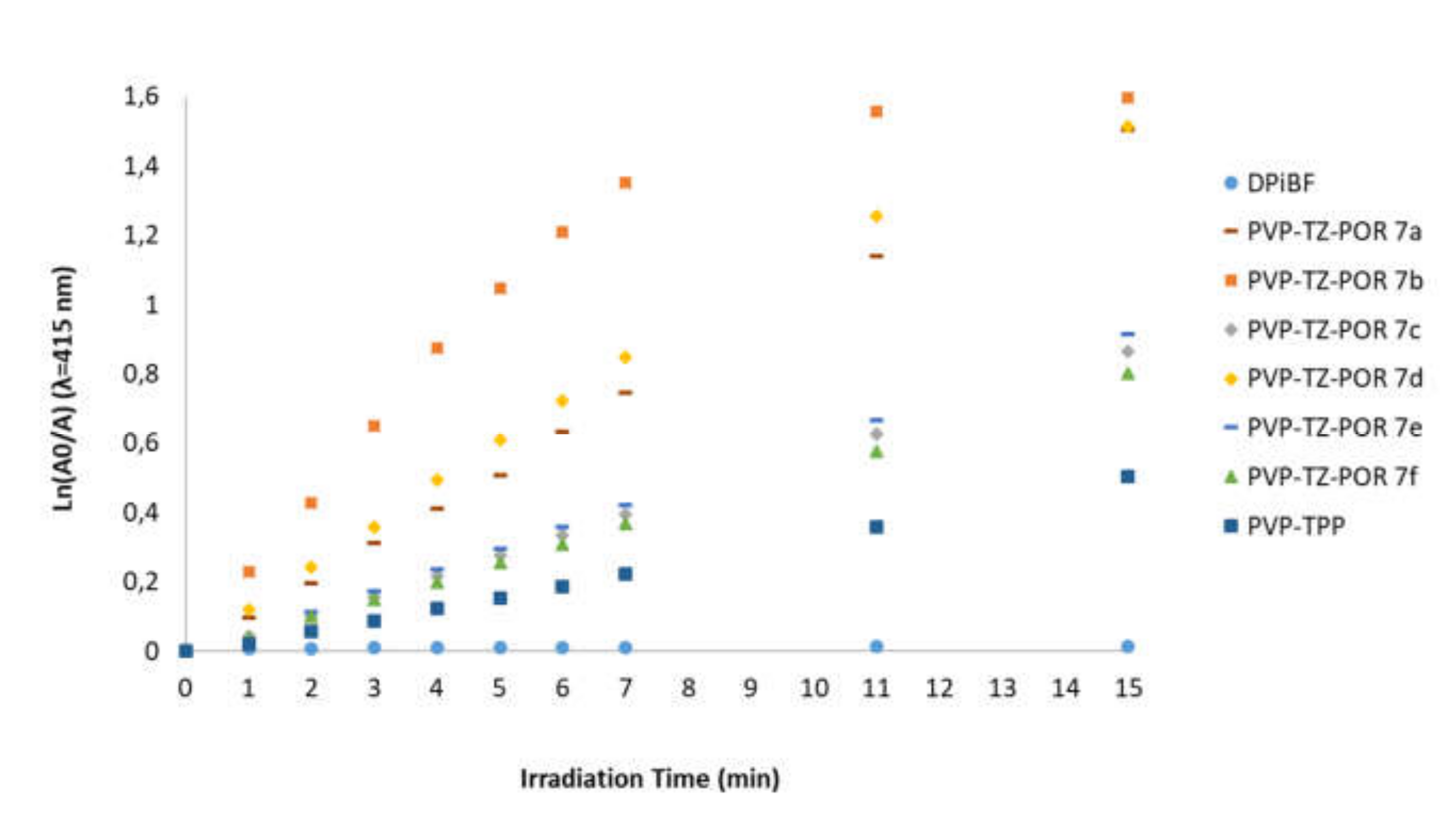

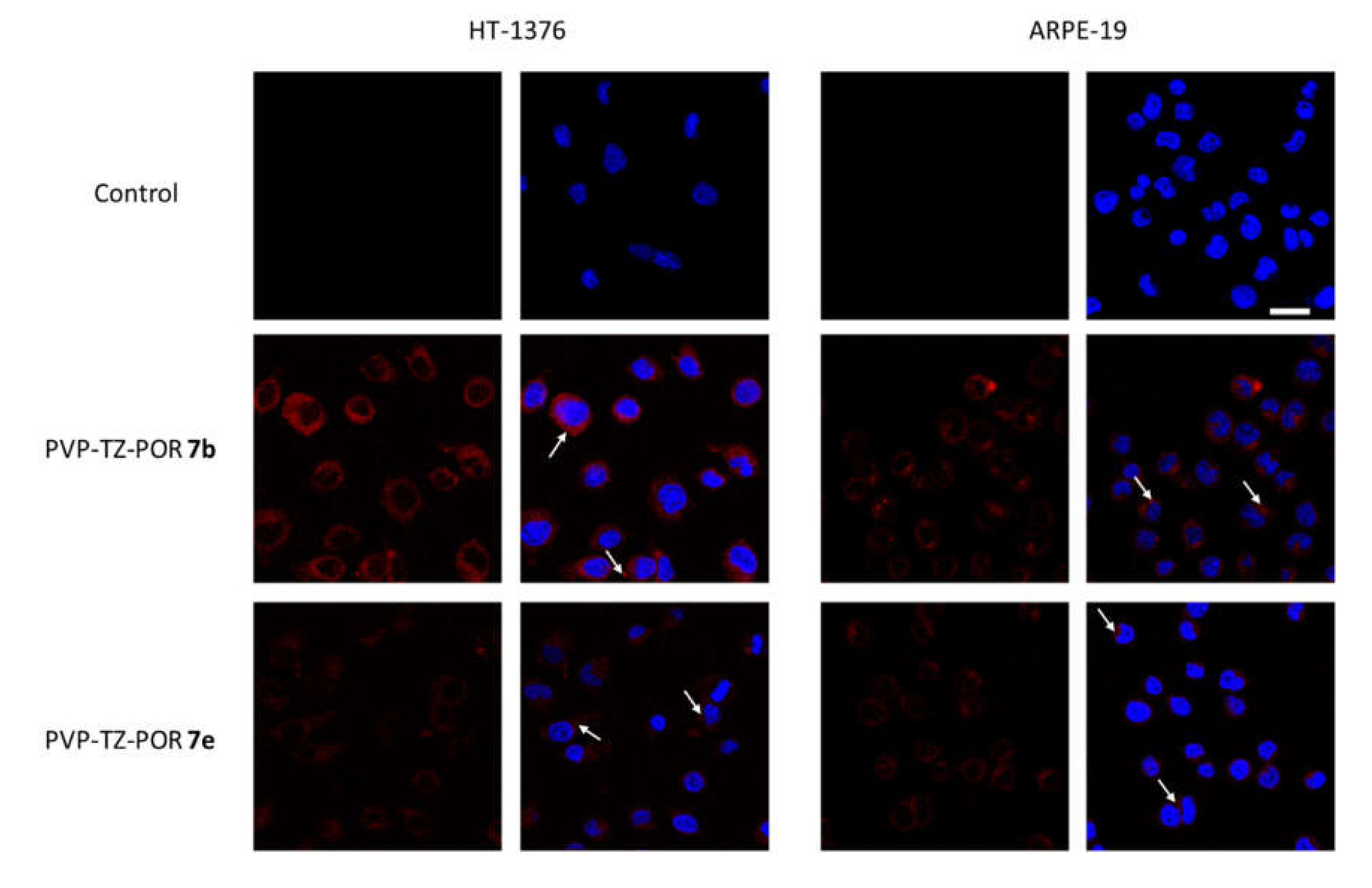
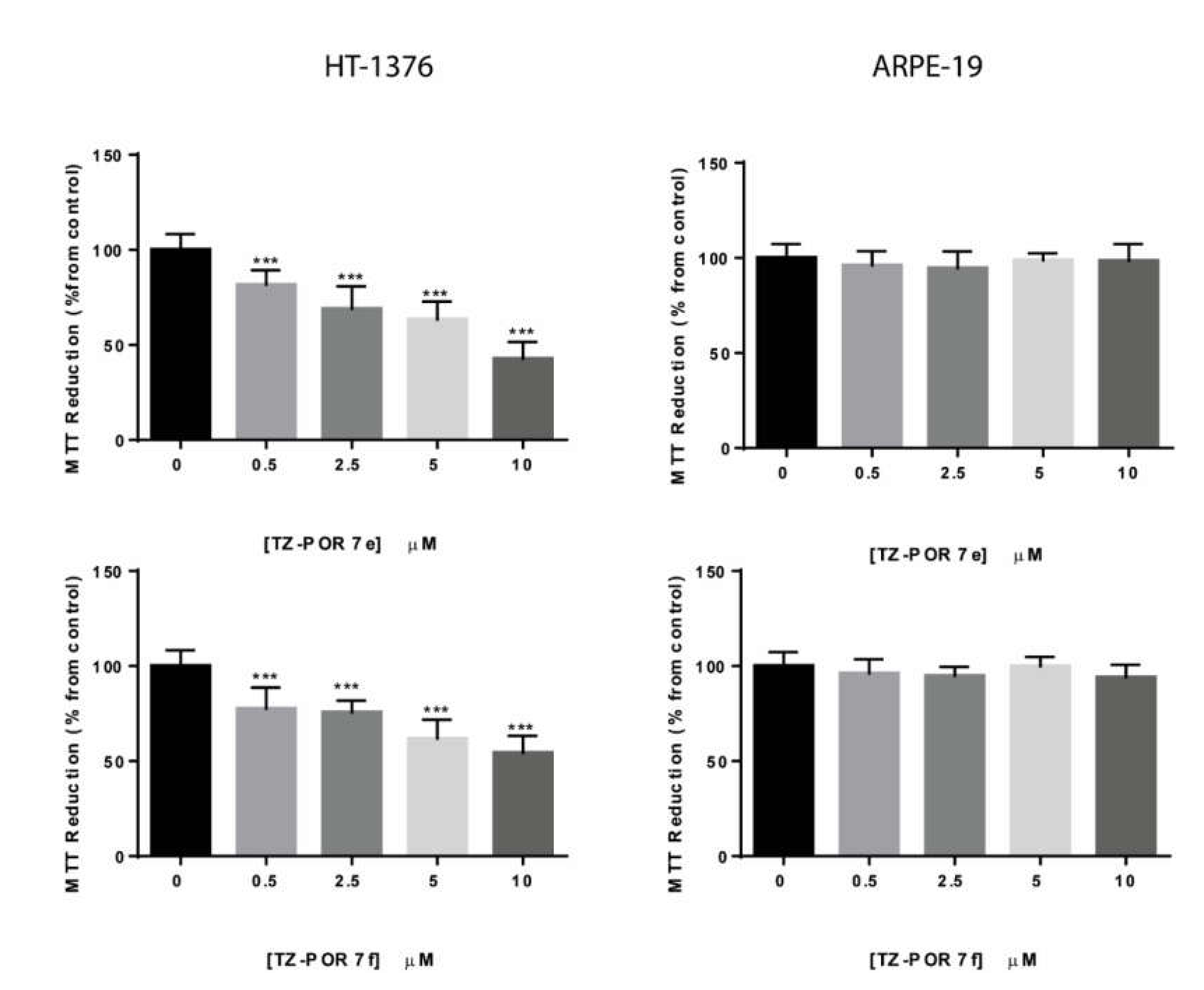
| Entry | Figure | MTT reduction (% of control) HT-1376 (±SD) | MTT reduction (% of control) ARPE-19 (±SD) |
|---|---|---|---|
| 1 | PVP-TZ-POR 7a | 28.74 ± 2.74 | 40.80 ± 3.89 |
| 2 | PVP-TZ-POR 7b | 69.50 ± 3.09 | 74.97 ± 2.85 |
| 3 | PVP-TZ-POR 7c | 20.46 ± 4.03 | 65.48 ± 3.70 |
| 4 | PVP-TZ-POR 7d | 24.30 ± 1.87 | 58.50 ± 3.15 |
| 5 | PVP-TZ-POR 7e | 42.75 ± 3.57 | 98.44 ± 3.35 |
| 6 | PVP-TZ-POR 7f | 54.34 ± 3.99 | 94.02 ± 2.51 |
| 7 | PVP-TPP | 63.84 ± 2.00 | 46.91 ± 3.85 |
© 2020 by the authors. Licensee MDPI, Basel, Switzerland. This article is an open access article distributed under the terms and conditions of the Creative Commons Attribution (CC BY) license (http://creativecommons.org/licenses/by/4.0/).
Share and Cite
Gomes, A.T.P.C.; Fernandes, R.; Ribeiro, C.F.; Tomé, J.P.C.; Neves, M.G.P.M.S.; Silva, F.d.C.d.; Ferreira, V.F.; Cavaleiro, J.A.S. Synthesis, Characterization and Photodynamic Activity against Bladder Cancer Cells of Novel Triazole-Porphyrin Derivatives. Molecules 2020, 25, 1607. https://doi.org/10.3390/molecules25071607
Gomes ATPC, Fernandes R, Ribeiro CF, Tomé JPC, Neves MGPMS, Silva FdCd, Ferreira VF, Cavaleiro JAS. Synthesis, Characterization and Photodynamic Activity against Bladder Cancer Cells of Novel Triazole-Porphyrin Derivatives. Molecules. 2020; 25(7):1607. https://doi.org/10.3390/molecules25071607
Chicago/Turabian StyleGomes, Ana T. P. C., Rosa Fernandes, Carlos F. Ribeiro, João P. C. Tomé, Maria G. P. M. S. Neves, Fernando de C. da Silva, Vítor F. Ferreira, and José A. S. Cavaleiro. 2020. "Synthesis, Characterization and Photodynamic Activity against Bladder Cancer Cells of Novel Triazole-Porphyrin Derivatives" Molecules 25, no. 7: 1607. https://doi.org/10.3390/molecules25071607
APA StyleGomes, A. T. P. C., Fernandes, R., Ribeiro, C. F., Tomé, J. P. C., Neves, M. G. P. M. S., Silva, F. d. C. d., Ferreira, V. F., & Cavaleiro, J. A. S. (2020). Synthesis, Characterization and Photodynamic Activity against Bladder Cancer Cells of Novel Triazole-Porphyrin Derivatives. Molecules, 25(7), 1607. https://doi.org/10.3390/molecules25071607










